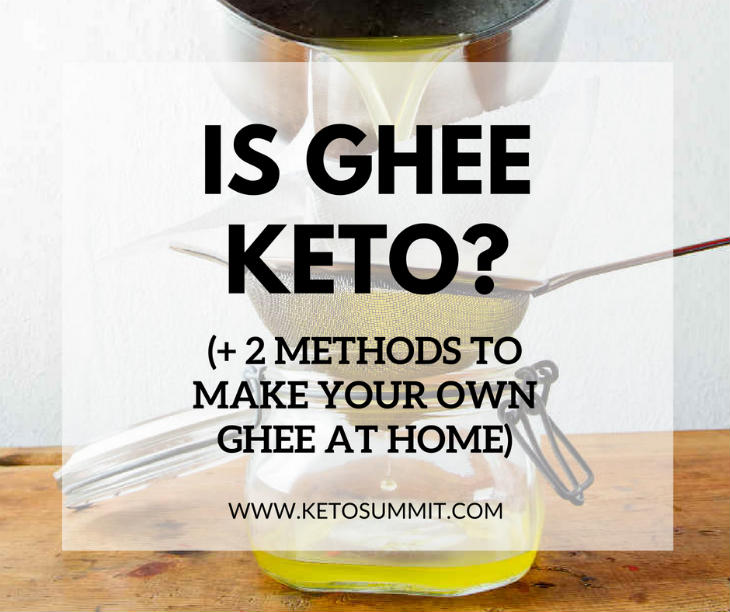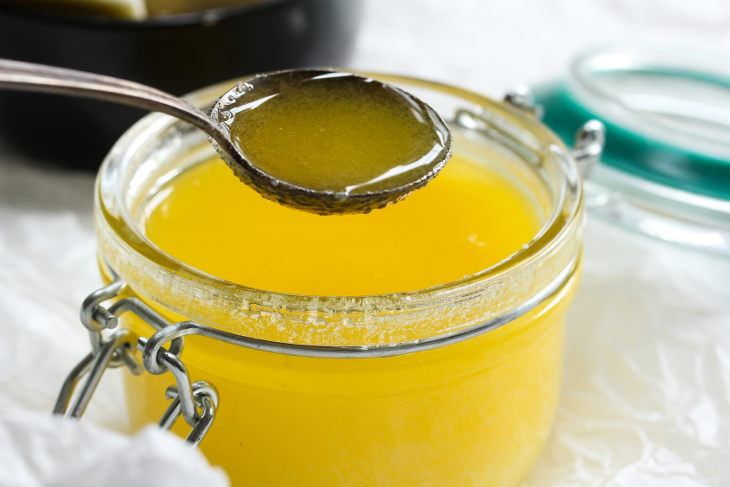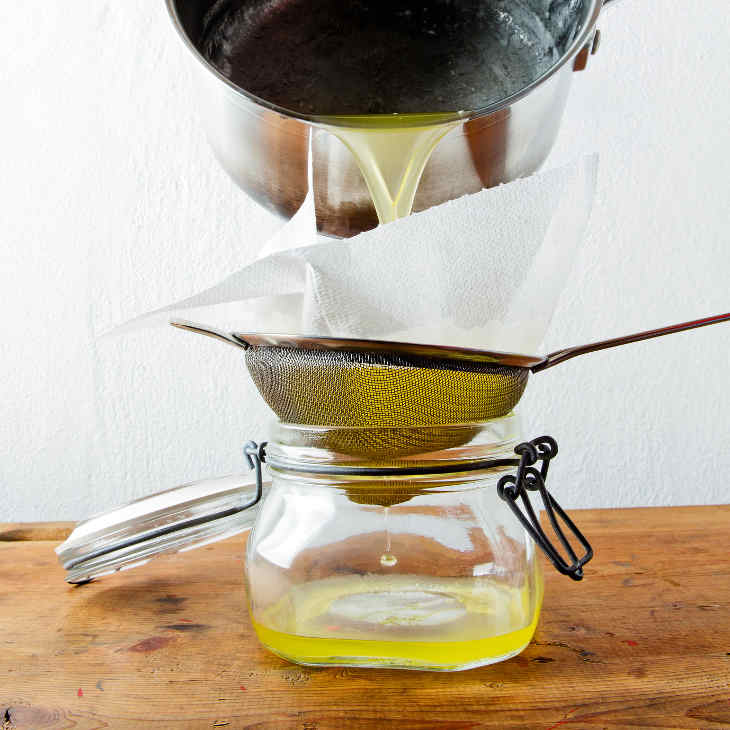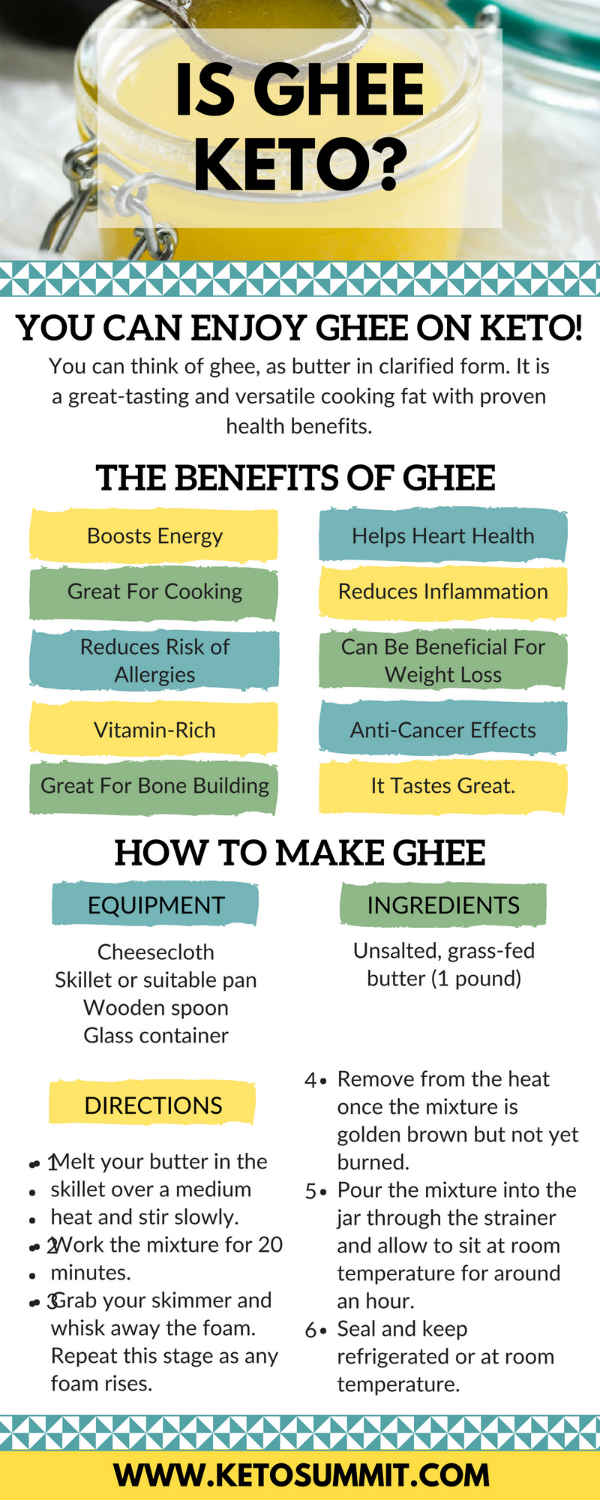Is Ghee Keto? (+ 2 Methods to Make Your Own Ghee at Home)
An Eastern staple for generations, ghee is rapidly gaining currency among Keto lovers.
What could be better than a substance said to taste more buttery than butter?

What Is Ghee?
You can think of ghee, a very stable cooking fat, as butter in clarified form.
Heating butter leads to the separation of the liquid butterfat and the milk solids which float on up to the top. This process leaves you with clarified butter.
With the milk solids removed, ghee is virtually free of milk sugars and proteins, making it a smart choice for anyone with lactose intolerance or sensitivity to the proteins in dairy. And that’s why we think ghee is way better than butter on Keto!
Is Ghee Keto?
YES! Ghee is great for Keto.
Ghee is a great choice for those on Keto who want a great-tasting and versatile fat with proven health benefits. Unless you’re very intolerant to dairy (e.g., lactose or casein allergies), ghee is delicious and healthy for a ketogenic diet. Add it to your Keto coffee, cook with it, and spread it on Keto bread.
We’ll glance now at some of the best things about this Keto-friendly fat. (Check out this list of keto fats for more options.)
The Many Benefits Of Ghee
- Boosts Energy: The wide range of fats in ghee include medium-chain fatty acids, which can be readily processed for ketone production and quick energy.
- Great For Cooking: Ghee has a very high smoke point of 485 degrees, higher than most oils, making it the perfect Keto-friendly cooking fat.
- Vitamin-Rich: Like butter, high-quality ghee is packed with nutrients including the fat-soluble vitamins. (1) Vitamin K2 can actually be hard to come by in food and has many health benefits of its own. (2) Dr. Taz Bhatia, M.D. says, “In general, healthy natural fats such as and avocado, olive & coconut oils and ghee (clarified butter) are nourishing on the digestive tract and necessary for the absorption of vitamins A, D, E & K.”
- Reduces Risk of Allergies: With the dairy sugars and proteins cooked away, ghee gives you that tempting taste of butter without the potential downsides of dairy.
- Great For Bone Building: The vitamin K2 in ghee helps proper bone growth and development while also safeguarding your arteries against atherosclerosis. (3)
- Helps Heart Health: A diet rich in ghee reduces the risk factors for heart disease. (4) One study actually showed less heart disease among men who consumed more ghee. (5)
- Can Be Beneficial For Weight Loss: Ghee contains CLA (conjugated linoleic acid), a fatty acid that has been linked to weight loss. (6) Also, the medium-chain triglycerides in ghee are hard for the body to store, potentially helping you to shift a few pounds. (7)
- Reduces Inflammation: Ghee contains butyric acid, a highly ketogenic short-chain fatty acid that has anti-inflammatory effects. (8,9)
- Anti-Cancer Effects: The butyrate in ghee also has several properties that make it protective against cancer. (10)
- Makes Beautiful Children: Clinical Nutritionist Josh Gitalis, IFMCP, says, “If you’re planning on trying to conceive anytime soon, vitamin K2 is an important nutrient to incorporate into your diet. According to the Weston A. Price Foundation, vitamin K2 plays a crucial role in facial and dental development. Children born to mothers with high levels of vitamin K2 are more likely to have wide, symmetrical faces with plenty of room for straight, healthy teeth later on.”
If you’re feeling creative you can make ghee for yourself so you can enjoy it freshly made.

How To Make Ghee (2 Methods)
You can buy ghee quite readily in most health stores, grocery stores and supermarkets. Because it’s stable at room temperature, you’ll generally find it nestled on a shelf somewhere near the coconut oil.
Organic, grass-fed ghee is the gold standard, but how about making some for yourself? It’s really not hard and you’ll end up with such a delicious alternative to butter, you’ll wonder why you didn’t convert to ghee sooner.
The basis of great ghee is great butter so don’t scrimp on your ingredients.
Ingredients for making ghee:
- Unsalted, grass-fed butter (1 pound)
Equipment for making ghee:
- Cheesecloth
- Skillet or suitable pan
- Wooden spoon
- Glass container
Method 1: Make ghee on the stovetop
- Gradually melt your butter in the skillet over a medium heat. Be prepared for some splashback and stir slowly with the wooden spoon while keeping the mixture at an even simmer.
- Work the mixture for 20 minutes stirring from time to time. You’ll see the milk proteins coming away from the golden base.
- Grab your skimmer and whisk away the foam. Repeat this stage as any foam rises.
- You can watch the milk fats starting to caramelize on the bottom now. This stage imbues your ghee with that hallmark nutty taste.
- Remove from the heat once the mixture is golden brown but not yet burned. You’ll need to monitor proceedings closely to achieve this.
- Pour your mixture into the jar through the strainer and allow to sit at room temperature for an hour or so.
- Seal and keep refrigerated or at room temperature and you’re ready to roll, dairy free!

Method 2: Make ghee in the crockpot or slow cooker
Don’t want to go through the hassle of keeping an eye on the saucepan to make ghee at home?
Here’s an easier method…make ghee in the slow cooker at home. Watch the video or scroll down for instructions.
- Add your sticks of butter into crockpot or slow cooker. You need to place the crockpot lid on but with a slight gap so that the steam can escape.
- Keep the crockpot on low heat for around 3 hours. The milk solids will brown and fall to the bottom of the crockpot and the bubbles on top will decrease.
- Let it cool a bit and then strain the liquid through the cheesecloth and into the funnel and into the mason jar.
How should you store ghee? “Ghee does not need to be refrigerated. Because the water content of ghee is minimal…ghee stays fresh for much longer than butter,” says Vrinda Devani, M.D. “In fact, as long as it is kept sealed and in a light-proof, dry area, ghee will keep for a year or more easily.”
Ghee isn’t hard to make, but if you’d rather buy it, Nutritionist Monica Reinagel, LD/N, CNS has some sound advice. “Ghee is traditionally made from cow’s milk but I’ve seen ghee made from sheep and goat milk as well. Just steer clear of anything labeled “vegetable ghee,” which is usually made from hydrogenated vegetable oils.”
Jewels Doskicz, RN, a Registered Nurse living with autoimmune conditions says, “If you have celiac disease and are lactose intolerant this is the product for you. Ghee can be found at most natural food grocery stores and is well worth the extra money spent. Because of the rich flavor imparted in this oil, ghee can be used sparingly and is suitable to all diets.”
Other Keto Fats We Recommend Using
If you like a little variety in your diet, here’s a list of healthy fats ideal when you’re on Keto.
For anyone intimidated by the idea of going without dairy, here’s a helpful guide to swapping out products, much like replacing butter with ghee.
Pinterest Image For Is Ghee Keto? (+ 2 Methods to Make Your Own Ghee at Home)
Please pin the image below so that you and others can quickly and easily refer to the list and start enjoying the benefits of ghee today!

